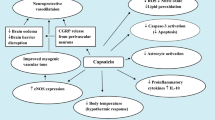Abstract
In a rat model of streptozotocin (STZ)-induced diabetes, we earlier showed that under these conditions the concentration of free cytosolic Ca2+ in input neurons of the nociceptive system increases, Ca2+ signals are prolonged, while Ca2+ release from intracellular calcium stores decreases. The aim of our study was to test the hypothesis that changes in the activities of Ca2+,Mg2+-ATPases of the endoplasmic reticulum (SERCA) and plasmalemma (PMCA) could be responsible for diabetes-induced disorders of calcium homeostasis in nociceptive neurons. We measured the Ca2+,Mg2+-ATPase activities in microsomal fractions obtained from tissues of the dorsal root ganglia (DRG) and spinal dorsal horn (DH) of control rats and rats with experimentally induced diabetes. The integral specific Ca2+,Mg2+-ATPase activity in microsomes from diabetic rats was lower than that in the control group. The activity of SERCA in samples of DRG and DH of diabetic rats was reduced by 50 ± 8 and 48 ± 12%, respectively, as compared with the control (P < 0.01). At the same time, the activity of PMCA decreased by 63 ± 6% in DRG and by 60 ± 9% in DH samples (P < 0.01). We conclude that diabetic polyneuropathy is associated with the reduction of the rate of recovery of the Ca2+ level in the cytosol of DRG and DH neurons due to down-regulation of the SERCA and PMCA activities.
Similar content being viewed by others
REFERENCES
M. J. Millan,“The induction of pain:an integrative review,” Prog.Neurobiol.,57,No.1,1–164 (1999).
E. Kostyuk, N. V. Bulgakova, and D. A. Vasilenko, “Parameters of conduction via afferent nerve fibers in mice with streptozotocin-induced and genetically determined diabetes,” Neirofiziologiya/Neurophysiology, 28, Nos.4/5, 135–173 (1996).
E. Kostyuk, N. Pronchuk, and A. Shmigol,“Calcium signal prolongation in sensory neurons of mice with experimental diabetes,” NeuroReport, 6, No.7,1010–1012 (1995).
N. V. Voitenko, I. A. Kruglikov, E. P. Kostyuk,et al.,“Effect of streptozotocin-induced diabetes on the activity of calcium channels in rat dorsal horn neurons,” Neuroscience,95,No.2,519–524 (2000).
N. V. Voitenko, E. P. Kostyuk, I. A. Kruglikov,etal., “Changes in calcium signaling in dorsal horn neurons in rats with streptozotocin-induced diabetes,” Neuroscience, 94,No.3,887–890 (1999).
I. Kruglikov, O. Gryshchenko, L. Shutov,etal.,“Diabetes-induced abnormalities in ER calcium mobilization in primary and secondary nociceptive neurons,” Pflügers Arch.,448,No.4,395–401 (2004).
J. Meldolesi,“Rapidly exchanging Ca 2+ stores in neurons: molecular, structural and functional properties,” Prog. Neurobiol.,65,No.3,309–338 (2001).
T. Pozzan, R. Rizzuto, P. Volpe,etal.,“Molecular and cellular physiology of intracellular calcium stores,” Physiol.Rev.,74,No.3,595–636 (1994).
O. Thastrup, P.J. Cullen, B.K. Drobak,etal., “Thapsigargin, a tumor promoter, discharges intracellular Ca 2+ stores by specific inhibition of the endoplasmic reticulum Ca2+-ATPase,” Proc.Natl.Acad.Sci.USA,87, No.7,2466–2470 (1990).
C. D. Benham, M. L. Evans, and C. J. McBain,“Ca 2+ efflux mechanisms following depolarization-evoked calcium transients in cultured rat sensory neurons,” J.Physiol., 455,567–583 (1992).
T. J. Huang, N. M. Sayers, P. Fernyhough,etal.,“Diabetes-induced alterations in calcium homeostasis in sensory neurons of streptozotocin-diabetic rats are restricted to lumbar ganglia and are prevented by neurotrophin-3,” Diabetologia,45,No.4,560–570 (2002).
E. Kostyuk, N. Voitenko, I. Kruglikov,etal.,“Diabetes-induced changes in calcium homeostasis and the effects of calcium channel blockers in rat and mice nociceptive neurons,” Diabetologia,44,No.10,1302–1309 (2001).
I. Kruglikov, V. Shishkin, L. Shutov,etal.,“Long-term nimodipin treat mentreverses diabetes-induced changes in calcium signaling of rat nociceptive neurons,” J.Physiol., 543,Suppl.,33P (2002).
N. Voitenko, I. Kruglikov, L. Shutov,etal., “Relief of diabetes-induced changes in nociceptive system of nimodi pin-treated rats,” Diabetes,51,A195 (2002).
C. H. Fiske and Y. Subbarow,“The colorimetric determination of phosphorus,” J.Biol.Chem.,66,375–400 (1925).
G. Biessels and W. H. Gispen,“The calcium hypothesis of brain aging and neurodegenerative disorders: significance in diabetic neuropathy,” Life Sci.,59,Nos.5/6,379–387 (1996).
G. J. Biessels, M. P. ter Laak, F. P. Hamers,etal., “Neuronal Ca2+ disregulation in diabetes mellitus,” Eur.J. Pharmacol.,447,Nos.2/3,201–209 (2002).
N. Svichar, V. Shishkin, E. Kostyuk,etal., “Changes in mitochondrial Ca2+ homeostasis in primary sensory neurons of diabetic mice,” NeuroReport,9,No.6,1121–1125 (1998).
W. J. Pottorf and S. A. Thayer,“Transientrise in intracellular calcium produces a long-lasting increase in plasma membrane calcium pump activity in ratsensory neurons,” J.Neurochem.,83,No.4,1002–1008 (2002).
Y. M. Usachev and S. A. Thayer,“Ca2+ influx in resting rat sensory neurons that regulates and is regulated by ryanodine-sensitive Ca2+ stores,” J.Physiol.,519,115–130 (1999).
Y. M. Usachev, S. J. DeMarco, C. Campbell,etal., “Bradykinin and ATP accelerate Ca2+ efflux from rat sensory neurons via protein kinase C and the plasma membrane Ca2+ pump isoform 4,” Neuron,33,No.1,113–122 (2002).
J. L. Werth, Y. M. Usachev, and S. A. Thayer,“Modulation of calcium efflux from cul tured rat dorsal root ganglion neurons,” J. Neurosci.,16,No.3,1008–1015 (1996).
C. Beaudu-Lange, A. Colomar, J. M. Israel, etal., “Spontaneous neuronalactivity in organotypic cultures of mouse dorsal root ganglion leads to upregulation of calcium channel expression on remote Schwann cells,” Glia,29,No.3,281–287 (2000).
T. Moller,“Calcium signaling in microglialcells,” Glia, 40,No.2,184–194 (2002).
P. G. Kostyuk and A. N. Verkhratsky,“Calcium signaling in the nervous system,” in:Calcium Signaling in the Nervous System,J. Wiley, New York (1995),pp.1–206.
L. Fresu, A. Dehpour, A. A. Genazzani, etal.,“Plasma membrane calcium ATPase isoforms in astrocytes,” Glia, 28,No.2,150–155 (1999).
Author information
Authors and Affiliations
Rights and permissions
About this article
Cite this article
Fedirko, N., Vats, Y., Kruglikov, I. et al. Role of Ca2+,Mg2+-ATPases in Diabetes-Induced Alterations in Calcium Homeostasis in Input Neurons of the Nociceptive System. Neurophysiology 36, 169–173 (2004). https://doi.org/10.1023/B:NEPH.0000048339.09774.09
Issue Date:
DOI: https://doi.org/10.1023/B:NEPH.0000048339.09774.09




